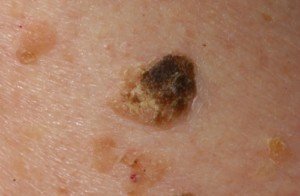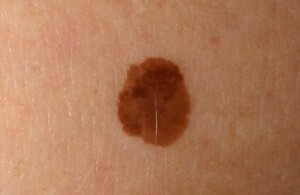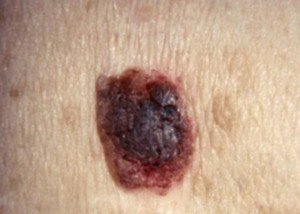
The sometimes rapidly changing growth of a seborrheic keratosis can fool people into thinking they have a melanoma.
But not all seborrheic keratoses grow quickly.
And yes, these benign skin barnacles can look just like a melanoma (and vice versa!).
Plus, they can also strongly resemble a dysplastic nevus (atypical mole).

Seborrheic keratosis or skin barnacle
Growth Rate of a Seborrheic Keratosis
“There are different types of seborrheic keratoses — can be flat, thick, small (1-2 mm), or reaching the more typical size of a thumb nail – about 1 cm – in a short time,” explains Sharyn Laughlin, MD, board certified dermatologist and co-founder of the DermaEnvy Skincare ™ line of sun protection products and medical director of Laserderm, a pioneering laser skin surgery clinic in Ottawa, Ontario, Canada.
“They can be white, black or brown; smooth (adenoid type) or very rough (verrucous),” continues Dr. Laughlin. They can also be tan.
“They come in crops, sometimes grow quickly with hormonal changes, and are not limited to sun exposed areas since they are not UVR induced.”
This is why these benign lesions can often sprout up on someone’s back or even genital area.
“They come on with advancing age. It does not matter what it looks like and how fast it has grown — the dermatologist can usually tell the difference after clinical and dermatoscopic examination.”
A dermatoscope is a handheld lens that allows a dermatologist to view intricate details, under magnification, of the lesion of interest.
People as young as 40 can begin developing seborrheic keratoses, and may develop hundreds just on their back.
In isolation they can strongly resemble a mole, but when they’re in highly clustered numbers, they often look as though they’ve been splattered on the skin.

A splattering of seborrheic keratoses. James Heilman, MD, CreativeCommons
Dr. Laughlin says, “In cases of doubt, excision and pathologic exam will solve the puzzle.”
A seborrheic keratosis that has looked the same for a very long time can suddenly start changing in appearance.
This does not mean cancer if it’s only the barnacle that’s changing.
But you should get it checked anyways to make sure there’s not a melanoma springing up among the melanocytes (melanin cells) next to the barnacle.
In other words, a melanoma and a seborrheic keratosis can, by chance, share real estate.

 In practice for 30+ years,
In practice for 30+ years, 







































